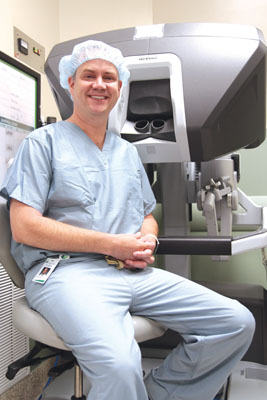Treasured Chest
Minimally invasive cardiothoracic surgery is changing how diseases of the chest are treated
Our chest is home to our heart and our lungs. It also houses our esophagus, trachea, and diaphragm. In short, it’s a very important place.
At one time, if any one of those organs or other internal structures needed surgery, it began with a big incision and often ended with post-operative pain and breathing problems.
 “Many people couldn’t tolerate those operations,” says Marc Bailey, MD, of St. Joseph's/Candler Medical Group - Cardiothoracic Surgery. Dr. Bailey is a fellowship-trained and board-certified cardiothoracic surgeon who has seen his field change with advances in minimally-invasive surgery, including robotics.
“Many people couldn’t tolerate those operations,” says Marc Bailey, MD, of St. Joseph's/Candler Medical Group - Cardiothoracic Surgery. Dr. Bailey is a fellowship-trained and board-certified cardiothoracic surgeon who has seen his field change with advances in minimally-invasive surgery, including robotics.
“New surgical approaches to the heart, lung, and other structures in the chest have resulted in better patient recovery, less pain, and minimal blood loss,” Bailey says. “It also is better for a patient’s cancer prognosis because of the reduction of recovery time.”
The Thorax
The chest is also known as the thorax. Naturally, with a variety of organs and tissue within one area comes a variety of potential conditions, including coronary artery disease, congestive heart failure, lung cancer, esophageal cancer, and mediastinal (central area of the thoracic cavity) tumors. When a condition requires surgery, patients turn to cardiothoracic surgeons like Dr. Bailey.
“We treat diseases of the chest—we work on anything that goes from your neck down to your abdomen,” Bailey says.
As your chest is protected by your ribs, certain procedures such as a lobectomy (removing a section from the lung where a tumor is located) traditionally required a thoracotomy, cutting and spreading the rib cage to access the area. But whenever possible, Dr. Bailey treats patients with robotic technology that can maneuver through the ribs, avoiding the thoracotomy and the pain and longer hospital stay that follow it.
The da Vinci Xi
“Robotic surgery has changed my practice,” Bailey says. “For example, it allows me to remove large tumors from the lung or the mediastinum without spreading the ribs. With a short operation and quicker recovery, my patients are moving around sooner. Many lung cancer patients don’t have the best lung function as it is…they usually have a significant smoking history and they may have emphysema. We don’t want the procedure to cause more shortness of breath.”
 The robotic surgical system used by Dr. Bailey and the other cardiothoracic surgeons at St. Joseph’s/Candler is the da Vinci Xi. The Xi is the fourth generation in da Vinci technology and recently joined three da Vinci Si systems already in place.
The robotic surgical system used by Dr. Bailey and the other cardiothoracic surgeons at St. Joseph’s/Candler is the da Vinci Xi. The Xi is the fourth generation in da Vinci technology and recently joined three da Vinci Si systems already in place.
“The latest iteration of the da Vinci is ideal for thoracic surgery,” Bailey says. “Its arms become the extension of my arms and hands. I can perform detailed dissections with minute movements and with no tremor. It also provides me with high-definition visualization that is unparalleled.”
Getting On With Life
Dr. Bailey notes that, in some cases, a traditional procedure with a thoracotomy is actually the most appropriate approach. He urges patients to discuss all options with their doctor to learn what the best fit for them is.
“Patients should always ask about minimally-invasive approaches, especially when dealing with the chest,” he says.
With robotics and other emerging surgical technology, the team at St. Joseph's/Candler Medical Group - Cardiothoracic Surgery is able to perform a number of different procedures without a large chest incision. Together, all of these advances help heart and lung patients with their recovery.
“With a minimally-invasive procedure, the hospital stay is shorter,” Bailey says. “People can get on with their daily life faster.”